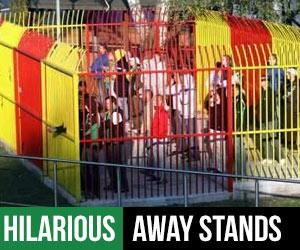Want to buy pyrotechnics? Visit pyro.ultras-tifo.net
 Information about the World Cup Stadiums!
Information about the World Cup Stadiums!
Information about the World Cup Stadiums!

See separate articles for Maracana, Estádio Joaquim Américo Guimarães, Arena das Dunas and Arena de São Paulo.
Stadium: Estádio Nacional Mané Garrincha (old Mané Garrincha Stadium).
City: Brasilia
Owner: TERRACAP - Agência de Desenvolvimento do Distrito Federal.
Built: Original in 1974, but demolished in 2010 and built again for the WC.
Capacity: 72 700
General view:
Estádio Nacional Mané Garrincha is a multi-purpose stadium originally built in 1974.
This is the biggest stadium in the capital of Brazil, but yet none of the biggest clubs in the city use the stadium as their home. The big question is what they are going to do with this 72 000 capacity stadium after the WC? None of the clubs in this area are not even close to gather that many fans for any match.
The original construction (stadium Mané Garrincha Stadium) was demolished in 2010 and this new top modern stadium, now named Estádio Nacional Mané Garrincha, opened in 2013.

The new stadium.

The old Mané Garrincha Stadium.
Stadium: Estádio Plácido Aderaldo Castelo
City: Fortaleza
Owner: State of Ceara
Built:1969, upgraded in 2001 and one more time in 2011 for the WC (car park under stadium, bigger roof, upgrading of the lower tier).
Capacity: 67 037 (record is 118 496!)
General view:
Estádio Plácido Aderaldo Castelo, also known at the Castelão or Gigante da Boa Vista, is the main stadium in Fortaleza.
Similar to the WC stadium in Brasilia there isn't any clubs using this stadium as their home ground. Sometimes Ceará Sporting Club (2nd division) play there, but usually they play their matches at Estádio Olímpico Horácio Domingos de Sousa in front of 3000-5000 spectators.
The other club worth to mention is Fortaleza Esporte Clube (3rd division), they play at Estádio Presidente Vargas. Capacity of 20 000, but normally only 4000-5000 spectators.

Estádio Plácido Aderaldo Castelo ready for the World Cup.

Estádio Plácido Aderaldo Castelo when it opened in 1973.
Stadium: Mineirão (officially Governor Magalhães Pinto Stadium)
City: Belo Horizonte
Owner: Minas Arena
Built: 1965
Capacity: 62 160 (record 132 834 spectators in 1997).
General view:
No doubt the largest stadium in the state of Minas Gerais. Even thought after imposition of FIFA the capacity has been reduced down to 62 000 spectators.
When Brazil won their bid to host the 2014 World Cup, it was clear that Mineirão needed to undergo a large redevelopment. The project included the complete reconstruction of the bottom tier, an extension of the roof, and further refurbishments to upgrade the stadium to FIFA standards.
Among the biggest clubs in the region is Cruzeiro Esporte Clube. They play their matches at Mineirão, even thought they are not close to fill the stadium on regular matches.
Others clubs worth to mention in the area is Clube Atlético Mineiro and América Futebol Clube , they play their matches at Estádio Independência (Capacity: 23 000).

The stadium after being upgraded for the WC.

The stadium in 1980.
Stadium: Estádio Beira-Rio
City: Porto Alegre
Owner: Sport Club Internacional
Built: 1969
Capacity: 51 300 (Record 106,554 spectators in 1972)
General view:
The stadium hardly changed over the next decades, and it was only when it got chosen as one of the playing venues of the 2014 World Cup that an extensive redevelopment was announced, which included the demolition and reconstruction of the lower tier and the construction of a new exterior and roof.
Estádio Beira-Rio is the home ground of Sport Club Internacional. Their main rival in the city is the other big club Grêmio Foot-Ball Porto Alegrense. They play at their new stadium Arena do Grêmio which was completed in 2012 with a capacity of 60 000 spectators. Even thought they got a new big stadium, Grêmio wont host the WC.

Stadium ready for the WC.

Estádio Beira-Rio before renovation.
Stadium: Itaipava Arena Fonte Nova (Also known as Complexo Esportivo Cultural Professor Octávio Mangabeira).
City: Salvador
Owner: Bahia State Government
Built: 2013
Capacity: 55 000
General view:
The stadium was built for the world cup in the place of the older stadium Estádio Fonte Nova which was built in 1951. Record attendance in the old stadium was incredible 110 000 on a match in 1989.On a match with 60 000 spectators in 2007 a section of the stadium's highest terraces collapsed and killed 7 fans.
Arena Fonte Nova is the home ground of Esporte Clube Bahia. Their rival Esporte Clube Vitória will use the same stadium for their high-profile matches, but normally they play in the 35 000 capacity stadium Barradão.

The new stadium.

The old Estádio Fonte Nova.
Stadium: Itaipava Arena Pernambuco
City: Recife
Owner: Clube Náutico Capibaribe
Built: 2013
Capacity: 46 000
General view:
This stadium was built for the World Cup and Clube Náutico Capibaribe has started to use this stadium as their home ground.
Before Clube Náutico Capibaribe played in their old stadium Estádio dos Aflitos from 1939, with a maximum capacity of 19 800 spectators. A lovely stadium in the middle of town, now they moved out of town to a stadium way to big for their crowds.
Their main rival Sport Club do Recife will continue to play in their stadium Estádio Ilha do Retiro with a capacity of 35 000 spectators.

Itaipava Arena Pernambuco

Estádio dos Aflitos

Estádio Ilha do Retiro
Stadium: Arena Pantanal
City: Cuiabá
Owner: Unsure
Built: 2014
Capacity: 41 390
General view:
The Arena Pentanal replaced the old stadium Estádio José Fragelli which was built in 1973.
Once the World Cup is over, capacity will be reduced from 41,390 seats to about 28,000 seats by dismantling the upper parts of both ends. It will then become the permanent home of local sides Mixto EC and Cuiabá EC.

Arena Pantanal

The old Estádio José Fragelli.
Stadium: Arena da Amazônia
City: Manaus
Owner: Governo do Estado do Amazonas
Built: 2013
Capacity: 42 300
General view:
Arena da Amazônia replaced the old Vivaldão stadium, which used to be the main stadium of the city.
This stadium is also the home ground of the two rivals Nacional Futebol Clube and Atlético Rio Negro Clube.

The new WC stadium.

The old Vivaldão stadium.
Visit our World Cup forum zone for latest news during the tournament!
Source: www.stadiumguide.com , www.wikipedia.org
Follow us on our Ultras-Tifo Fanpage and get latest news/photos/ Videos.












